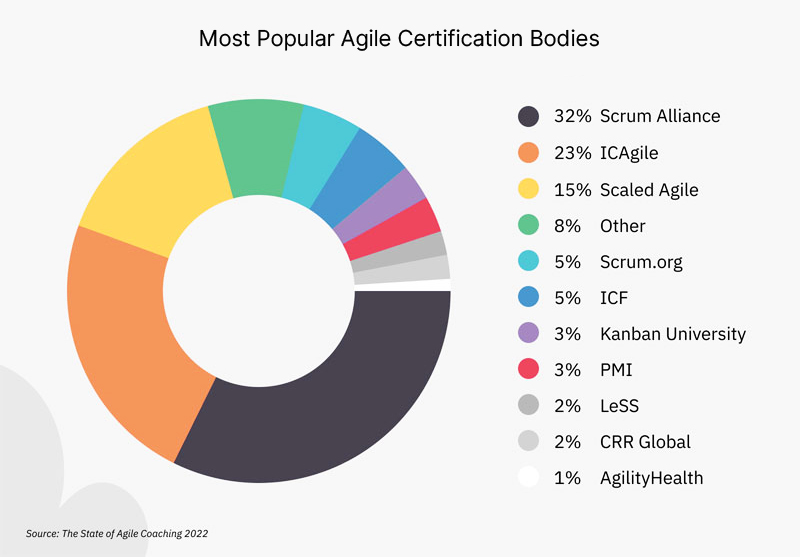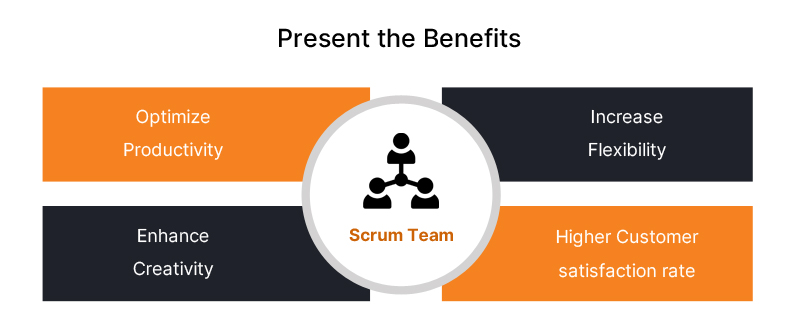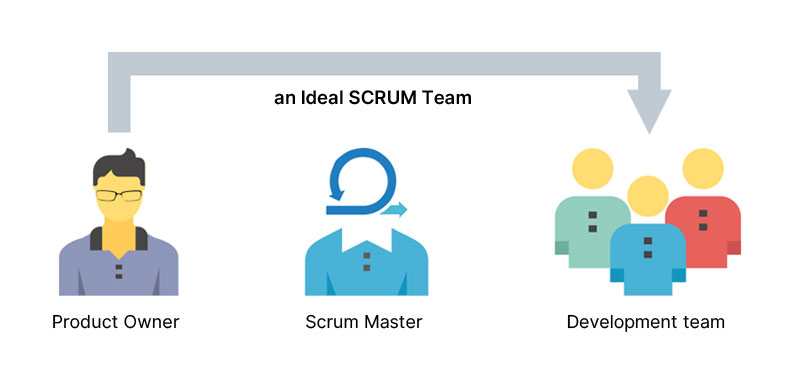Customers’ needs change daily in today’s marketplace. Businesses must be highly adaptive and responsive to such changes while delivering an excellent customer experience.
If you are a part of a software firm or a product-based organization, you may have heard about the Lean method, SCRUM teams, and Agile. These days, people are very concerned about these methods and want to sift through the excesses and inefficiencies in deliveries.
Why?
Adapt with the market. Prune dead weight. Get a faster time-to-market.

CTOs and CEOs want to increasingly focus on changing something that emphasizes how teams run and companies work.
And since the world is gearing up for remote work and staff augmentation services, it is necessary to understand a SCRUM Team model’s viability, relevance, and utility for Product-based startups and organizations.
Shifting to SCRUM Project Management
“”The art of doing twice the work in half the time” – Jeff Sutherland gets right to the heart of the impact of Agile and SCRUM.
Many business executives who have just started looking into SCRUM have begun asking themselves:
Why SCRUM, and how will it benefit my company?

In simple terms, SCRUM is a framework used to implement Agile development, or any such action requires organization. After this, the structure and management come into play, offering a robust product development methodology. This is often seen as the best and standard way to create digital products.
SCRUM Model – Whether or Not it is the Right Approach to Develop & Grow Your Product
The continuous growth and use of SCRUM have led to fulfilling customers’ needs as the project’s top business priority. It has also significantly improved with time to market and even reduced the dev cycle time.
- Optimize Productivity.
- Increase Flexibility.
- Enhance Creativity.
By utilizing SCRUM, organizations can help their employees dictate the course of progress and maintain a continual process. One that helps deliver products iteratively, helps manage goals and keeps alive, ready products available.
Thus, unsurprisingly, SCRUM’s success rate is spiraling upwards.
The state of SCRUM 2017-2018 facts has revealed that fully 97 percent of current users say they will continue to use SCRUM, and 85 percent say SCRUM improved their quality of work life.
What Makes the SCRUM Framework Succeed?
81% of agile teams report using some version of Scrum, including Scrumban or a hybrid Scrum model.
The SCRUM framework has changed the classical project management triangle, where quality is no longer an option and product iteration in sprints is a MUST. In the new framework, the course of the project is defined in the functionality to be implemented incrementally.
Various studies have shown the positive effects of SCRUM in practice for product companies:
- Increased productivity
- Better product quality
- Reduced project costs after the introduction of agile methods
- The higher customer satisfaction rate
- Increased satisfaction as well as the motivation of employees
The Structure of an Ideal SCRUM Team

The SCRUM Master, the product owner, and the development team members are the three different roles that make up a SCRUM team. Despite the fact that there is only one SCRUM master and one product owner, most development teams include numerous members.
Let’s look at the responsibilities of each of these roles in more detail:
1. A SCRUM Master
The SCRUM Master assists and coaches the Development Team and Product Owner in their daily development ventures.
SCRUM Master ensures that the team knows & can practice the values & principles of the SCRUM model. At the same time, the SCRUM Master provides that the team is passionate about Agile to get the most out of it. In addition, the SCRUM Master assists and supports the team in becoming self-organized.
Roles & Responsibilities
- For both the Development Team and the Product Owner, the SCRUM Master serves as an Agile Coach.
- Also, the SCRUM Master removes the impediments that prevent the team from completing tasks on time.
- The SCRUM Master also protects the SCRUM Team from outside influence and distractions, allowing them to focus on delivering the best results possible.
2. A Product Owner
SCRUM cannot function without the product owner. The product owner role comes with a large amount of responsibility.
The product vision must be clear and easy to understand to create alignment and a common purpose and to avoid misinterpretation and confusion – Lynn&Reilly 2002, Pichler 2008
According to SCRUM.org, if the product owner receives negative feedback from users and quickly changes the product without any time wastage, the speed of decision-making within the SCRUM model increases, resulting in organizational agility improvement. Moreover, adapting to the timely market demands allows SCRUM teams to create successful products.
The Product Owner is thus expected to participate in all sprint activities and development initiatives. It is a critical part of the Product’s success.
Roles & Responsibilities
- The Product Owner collaborates closely with internal & external stakeholders to understand requirements and preferences to bridge the gap.
- He manages the product backlog and orders things in the product backlog to meet the stakeholders’ needs, i.e., prioritization & finalization of product backlog items.
- His job is to certify the features that are being constructed. He defines the Acceptance Criteria for each Product Backlog Item during this procedure.
- A crucial participant in Sprint-related activities is the product owner. He collaborates closely with the development team to clarify the Items, their scope, and their usefulness.
3. The Development Team
The Development Team consists of professionals that are experts in their respective fields. The development team focuses on implementing the potentially deliverable software/increment due after each Sprint.
People with specialized expertise, such as Back-end/Front-end Developers, Dev-Ops, Business Analysts, QA Experts, and others, may be on the Development Team, but they are all referred to as Developers; no other titles are permitted.
Roles & Responsibilities
- The Development Team is responsible for creating and delivering the “done increment” for each Sprint that matches the ‘Definition of Done’ criteria.
- A Development Team’s other role is to develop tasks by breaking down Sprint Items and generating estimates for these Sprint Items.
Wrapping Up
As for clarity about the title, YES – a SCRUM team model works for product companies.
Therefore, whether you are a startup founder trying to enter the product market quickly and efficiently; or an established entrepreneur looking for a means to keep track of all the projects you’re working on, SCRUM Team Model is a preferable and a tried & tested solution for you!
Get an organized sprint backlog for your next project
with agile framewok to achieve success.
Contact Us Now
Summary
Kickstart Your Project With Us!
Blog
Popular Posts
CONTACT US
Let's Build Your Agile Team.
Experience Netsmartz for 40 hours - No Cost, No Obligation.
Connect With Us Today!
Please fill out the form or send us an email to
 Don't Miss Out:
Don't Miss Out: 







